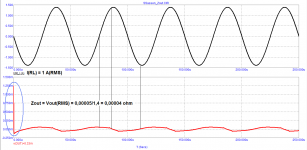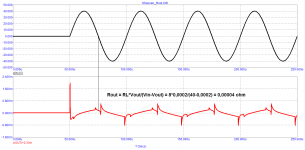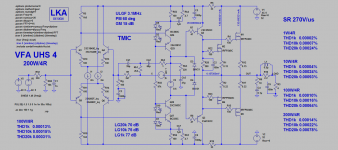With a stereo amp just drive one channel that feeds the output of the other channel through a low inductive dummy resistor. No need for a specific current source.😉Or since you are looking for the small signal Zout, short the amp input to ground, use an 1A current source to inject in the output node (this is also the phase reference), do a AC sweep, V(out) is exactly Zout. Plot Re{Zout} and Im{Zout}, done, aren't simulators convenient. This is a direct result of the superposition theorem, no other assumptions.
Here is the result of measuring the output impedance using current.The formula: Rout=RL*Vout/(Vin-Vout) is certainly not incorrect per se, but I would make two remarks: Rout can be useful, but for general information Zout has more value.
In the case of an amplifier, the numerical values of Rout and |Zout| can be quite different for a number of reasons. For a SS amplifier for example, the NFB often results in a mostly inductive Zout.
The output impedance can be derived more easily with: Zout=Vout/I(RL), and if needed Rout can be extracted by looking at the real part of Zout
What new information did you get from this test?
The output impedance is measured to calculate the damping factor There are several ways to measure the output impedance (impedance) of an amplifier.
You're right!bucks bunny:
“With a stereo amp just drive one channel that feeds the output of the other channel through a low inductive dummy resistor. No need for a specific current source. “
This method is suitable for measurements both virtually and in hardware.
Attachments
Last edited:
Petrov, do you understand the difference between measurement and simulation?Here is the result of measuring the output impedance using current...
Петров, вы понимаете разницу между измерением и моделированием?
Or since you are looking for the small signal Zout, short the amp input to ground, use an 1A current source to inject in the output node (this is also the phase reference), do a AC sweep, V(out) is exactly Zout. Plot Re{Zout} and Im{Zout}, done, aren't simulators convenient. This is a direct result of the superposition theorem, no other assumptions.
It is not necessary to short the amp input to ground, just not to set AC amplitude to 1 of the input voltage source.
Shorting the idle input may not be always be necessary but is definitely most accurate in all cases. Consider an inverting amp with open input - this will give wrong results.
It is not necessary to short the amp input to ground, just not to set AC amplitude to 1 of the input voltage source.
Which is, in effect, shorting the input. Shorting the input is absolutely necessary for accurate results with this method, otherwise there might be input-related currents that can create an input voltage that upsets the feedback loop.
Jan
Or since you are looking for the small signal Zout, short the amp input to ground, use an 1A current source to inject in the output node (this is also the phase reference), do a AC sweep, V(out) is exactly Zout.
Yes. And change "Y" axis scale from dB to linear.
This method can be very useful while designing inherently stable output EF-triple.
Just remove all unnecessary in this case feedback loops, create needed bias with working DC point and add realistic inductances of pins and traces.
the one who understands does not ask such questionsPetrov, do you understand the difference between measurement and simulation?
Петров, вы понимаете разницу между измерением и моделированием?
If you do understand, what is your motive to use incorrect word describing what you did?the one who understands does not ask such questions
Which is, in effect, shorting the input. Shorting the input is absolutely necessary for accurate results with this method, otherwise there might be input-related currents that can create an input voltage that upsets the feedback loop.
Jan
Yes, that is correct as the input voltage source in this case acts as short.
If you do understand, what is your motive to use incorrect word describing what you did?
Language problem as he still use OOS (in Russian) for NFB.
Pls do not feed it!If you do understand, what is your motive to use incorrect word describing what you did?
what word do you dislike?If you do understand, what is your motive to use incorrect word describing what you did?
To get the discussion back on track again, I’d be very interested in any suggestions for further improvements on this design, I’m sure there things I haven’t thought about and some of you might be thinking: Hey Sander, why don’t you try this ...
Hey Sander, why don’t you try this ...
Hey, Sander, why don't you try this:
????????? ????????? + ???????
- Home
- Amplifiers
- Solid State
- Simplicity and elegance, feedback wanted!


